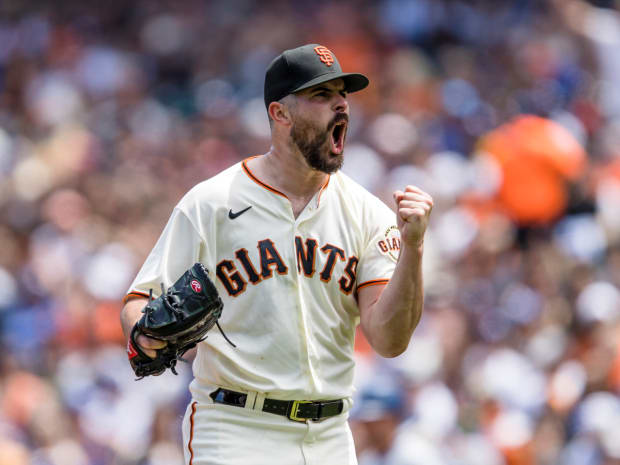Two years ago, the White Sox non-tendered Carlos Rodón because they didn’t think he was worth a raise from his $4.45 million salary. He had no place in their rotation. Anybody could have signed him. Chicago brought him back with a pay cut, to $3 million.
Twenty-four months later, the Yankees made Rodón the third most expensive left-handed pitcher in history. New York and Rodón agreed on the first six-year contract for a pitcher since 2019, at the cost of $162 million, a $27 million average annual value. David Price and Clayton Kershaw are the only lefthanders to sign contracts of greater overall and average annual values. Rodón, 30, has thrown only two qualified seasons.

John Hefti/USA TODAY Sports
The stunning turnaround is a result of Rodón rededicating—he has called the non-tender “a wake-up call”—and reinventing himself. With better mechanics and added bulk and velocity, Rodon threw more elevated fastballs last season than any MLB pitcher. His average four-seam velocity was 95.5 mph, up from 92.8 in 2020, when the White Sox non-tendered him.
Rodón also capitalized on several market forces: inflation in the first full free agency since the CBA was signed and the pressure on the Yankees to deal with the Astros … and the Mets.
Rodón is a near statistical clone of fellow lefty Robbie Ray when Ray hit the market last offseason. Both were 30 as free agents. Ray was coming off a Cy Young season. Ray was the more durable pitcher. In his career Ray was 62–58 with a 4.00 ERA, a 110 ERA+ and a 2.85 strikeout-to-walk rate. Rodón was 56–46 with a 3.60 ERA, a 115 ERA+ and a 2.97 strikeout-to-walk rate. Ray had thrown more innings, 1035 ⅔ to 847 ⅓, due in part to Rodón having Tommy John surgery in 2019.
Ray signed for five years and $115 million. Rodón topped that haul by one year and $47 million.
Most of the top end of the market this winter has been driven by teams weary of championship droughts, such as the Mets, Rangers and Padres. In their unique historical context, the Yankees also fit in that group, having last won the World Series in 2009.
After getting swept in the ALCS last season by Houston—the third time in six years New York could not get by the Astros—the Yankees knew in addition to re-signing Aaron Judge they needed to find swing-and-miss starting pitching, the kind that rules postseason play. After Jacob deGrom and Justin Verlander, Rodón was the best option in free agency—the only lefty and someone younger than those two righthanders.
Since Aaron Boone became manager, Yankees starters are 9–9 in 31 postseason games, including only six quality starts—four of them by Gerrit Cole. Rodón essentially makes for an upgrade over Jameson Taillon, who signed with the Cubs, and joins Cole, Nestor Cortes Jr., Luis Severino and Frankie Montas in the New York rotation.
Rodón was 14–8 with a 2.88 ERA for the Giants last season over a career-high 178 innings. The Yankees have not had a lefthander work that many innings since CC Sabathia in 2016. Rodón led the league with 12 strikeouts per nine innings.
Rodón’s new-found ability to throw the ball past people is the single biggest reason why the Yankees signed him. In getting swept by Houston in the ALCS, it was the most jarring difference between the two clubs. Yankees pitchers had only 25 strikeouts in the four games. Astros pitchers racked up 50.
The Yankees are betting on Rodón’s pure stuff more than his career track record. In 2019, for instance, Rodón threw his fastball 2.59 feet off the ground on average (about mid-zone) and hitters pounded it for a .350 average. Last year he threw it 3.05 feet off the ground on average—the top of the strike zone. Only Cristian Javier of the Astros had a higher average height on his heater. And it worked well and often for Rodón. Throwing 61% heaters, he allowed a .213 average on the pitch.
After the non-tender, in addition to the added muscle, Rodón overhauled his delivery. He “sat” more on a bent back leg, scrapped his short, crossfire stride for a longer, linear one and drove his head more toward the plate, getting over his front leg. It became a classic power pitcher’s delivery, with the stuff to match. After wearing down in 2021 with the Sox (132 ⅔ innings), Rodón broke out with his best season this year with the Giants.
Rodón’s fastball velocity did drop a tick in the final two months, from 95.9 to 94.9 mph. And he did show extreme ballpark splits, with a 1.93 ERA in pitcher-friendly Oracle Park and a 3.73 ERA on the road. He threw 16 quality starts, tied for 31st in the majors.
Make no mistake: the Yankees are making a six-year bet that this version of Rodón is sustainable—that he can not only help them get to the postseason but also through it. They stepped up on the heels of their cross-town rivals, the Mets, spending nearly half a billion dollars and blowing through every tier of competitive balance taxes. With a nine-year commitment to Judge and a six-year commitment to Rodón, the Yankees have $128 million tied up in 2027 just in Judge, Cole, Giancarlo Stanton and Rodón—when each of them will be between 35 and 38 years old.







